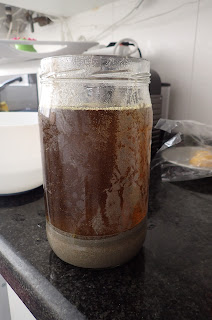My only beef with it for a long time is the smell.
It turns out that BLO isn't boiled at all. Nowadays, raw linseed oil (which works as a finish, but takes weeks to dry making it unhandy) is mass produced by adding metallic chemical drying agents such as manganese and cobalt which through the magic of chemistry makes the linseed oil dry relatively quickly.
A quick internet search produced a Material Safety Data Sheet (MSDS) for some BLO, which includes this:
Effects of Overexposure:
Inhalation: Vapors may cause irritation of the respiratory tract.
Skin: Prolonged or repeated skin contact may cause irritation or dermatitis.
Eyes: Contact with eyes may cause burning and tearing.
Ingestion: Ingestion of large amounts may cause gastrointestinal irritation.
Chronic: Not Available.
Overall, it looks pretty safe. But not totally. I wouldn't drink it.
Then, I was ruined by Dictum. They sell a Swedish cold-bleached linseed oil.
 |
| Linseed oil from Dictum. Also, some great smelling turpentine balsam, and some natural tung oil from Denmark. |
What could go wrong?
The first thing I found was this great YouTube video by Joe Besch:
I figure if this is good enough for the old masters, it should also work for woodworking.
Enough blah-blah. Let's get to work:
First, instead of pressing my own flax seed, I ordered a liter of pure, quality raw linseed oil from El Barco, a local paint shop in Valencia.
 |
| Raw linseed oil. |
I'm not sure, and if you would like to try it, I'm sure you'll have success using only tap water.
 |
| Believe it or not, you can buy sea water at a local grocer for 3.99/liter! |
 |
| beach sand and seawater. And who-knows-what. |
 |
| Filtering the sea water. |
 |
| The clean sand. |
 |
| Next I dumped in my raw linseed oil. |
 |
| Oil on top, the water sank below it, and the sand is on the bottom. |
 |
| After the mixture was shaken. Not stirred. |
Then, let it sit in the sun.
 |
| Waiting... |
 |
| After an hour. |
If you are wondering what you are looking at, you can clearly see everything settling in layers. The bottom is the sand, and the little black bubble looking things above that is actually clear water. It is heavier than the oil so it sinks to the bottom.
The yellow band is a layer of fat we've just rendered out of the raw linseed oil. I suspect this is the stuff that prevents raw linseed oil from drying quickly.
The brown layer on top is the good stuff.
 |
| The next morning. |
I'll follow Joe Besch's advice and do this process again with my refined oil. I imagine after a couple times of this, I should get some pretty nice quality stuff.
The last step is to let it rest in the sun for some weeks or months, and the yellow color will evaporate away.
For my purposes, it probably doesn't need to be crystal clear, but it will be fun to see how far I can take this.
There is likely to be quite a bit less than one liter of oil after this process, but what I have should be good.
I'm not sure if this will be worth it, but it is fun to see if it will work.
Keep an eye on this blog in the future, I plan to post on the results of this experiment over time.






